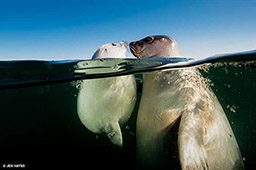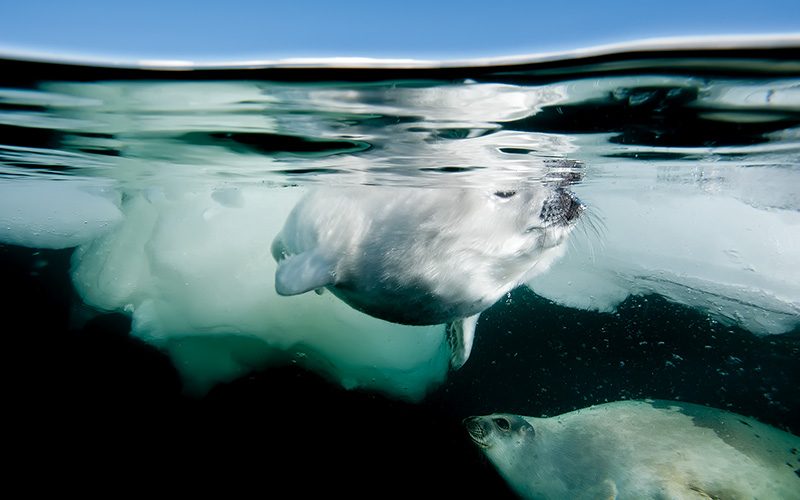
Harp seal pups, called whitecoats, are born on the ice in the Gulf of St. Lawrence in late February. Their mothers nurse them for 10-15 days and then abandon them, leaving to mate and migrate. The pups to learn to swim, hunt and survive on their own. It’s a tough beginning, and natural mortality is high even in a good year when the ice is thick and steady beneath them.
David Doubilet and I were on assignment with National Geographic among harp seals in the gulf’s icy waters. We were there to document their life in the ice in an unpredictable climate. During a good ice year you can walk for miles across the gulf, but this time we had to use helicopters just to locate ice and then found only small to moderate ice pans crowded with 10,000 mothers and pups near Prince Edward Island. Sadly there was more water than ice.
We pulled our fishing boat into the ice pack and stayed for several days, working with harp seal mothers and pups above and below the ice. There are no words to describe the experience of going to sleep in your bunk, lulled by the humanlike cries of harp seal pups. The sounds cross the night ice right into your dreams. It is otherworldly.

It was our last day and last dive of the expedition. We always hear about the great things that happen on colleagues’ last day in the field, such as, “I had no story until it all came together in an hour before I had to helicopter out.” Right. Our exciting last day usually consists of packing. We jumped into the cold water wearing drysuits, weight belts and snorkels. David and our superhero guide, Mario Cyr, found a pup right away. I swam off through the ice looking for my own subject. I found a pup with big liquid-black eyes peering into the water looking for its mother, who was behind me doing loops in the water, trying to distract me. She succeeded and shot past me to coax her pup into the water, where they met with a nose-to-nose kiss of kin recognition. It is a greeting ritual the seals engage in above and below the surface — Are you my pup/mother, or are you an imposter?
The mother seal led her pup away from me, the alien in the water. As I swam beside the pair the curious pup kept trying to approach me, but the anxious mom would physically restrain it with her flipper. After several minutes of swimming together the mother seal relaxed, and the pup drifted closer until it was at my elbow. I stopped, and the pup scrabbled onto my arm and then my chest as I lay backward in the water. I became a living raft for the resting pup, and it began to touch my mask with its nose as the mom circled us slowly, watching me carefully. I was contorted and cold and could not take a picture as my camera dangled on my arm. I was in the center of a potentially great picture I would have given anything to make, but I would not trade that moment for any other in the water.

After resting for a few short minutes the pup rolled off my chest and swam to its mother; she inspected him. I was shooting the scene like a maniac when I felt a nip on my left ankle followed by a nip on my right ankle. I looked down to see a carousel of male harp seals circling below me about 20 feet down. I didn’t have time to think or be concerned before a male scrabbled up my back and over my head, pushing me underwater and knocking off my mask in the chaos. I lunged for the mask and fumbled it onto my face just in time to see the female dive past me in a blur on her way to beat the crap out of the male. I watched a flurry of fur and fins beneath me before the male swam off.
I was not quite sure what to expect as the mother seal rose toward her pup and me, snorting mucus and bubbles. She swam around the pup to check him and began to nudge him through the water with her body. She stopped and swam over to me, and she began to slowly nudge me toward the pup.

I could not comprehend the moment as she herded the pup and me together away from the open water and the males. We were headed to a narrow lead between two sheets of ice. The small channel would be no place for a human or pup if the two ice sheets collided. I ducked around the female and watched for minutes as they swam out of sight.
I was exhausted but exhilarated; my mind was racing, and my bladder was full. I reached up and put my housing onto the edge of the ice. When I reached down to unbuckle my weight belt, a male seal came rocketing out from under the ice shelf and bit me hard, square in the groin. He let go and then bit me again on my upper thigh. Before I knew what had happened I was standing on the ice, favoring my right leg. I looked down and saw punctures in my heavy neoprene drysuit but no gaping gash that was spilling blood.

The captain saw me on the ice, wheeled his boat around and brought it crashing toward me. He dropped the gangway onto the ice with a thud, and I limped up the plank, lugging my camera.
I took off my drysuit and noticed the punctures were bigger than I thought. I headed downstairs to the shared bunkroom, where I took off my inch-thick underwear and saw the bite damage to my leg and groin. Luckily the combination of drysuit and underwear had prevented the seal’s teeth from penetrating my femoral artery. All could be patched up properly without much fuss, but I knew I’d need to see a doctor soon because of the risk of serious infection. I heard David come aboard, and the boat engines fired up to get us back to the Magdalen Islands ahead of a big storm that was coming our way.
The storm battered our boat and pummeled the weak ice to bits like a blender, drowning, crushing and killing the majority of the pups born that season in the Gulf of St. Lawrence. My pup friend was certainly dead, which made the beloved moments I spent with it and its mother a bitter but very special gift. I am always skeptical of “an animal saved me” stories, and I am grateful for this incredible encounter that prompted a change of heart. I have significant scars in awkward places to remind me of that day in the ice, but I also have memories of the female harp seal that defended me and then tried to herd her pup and me away from danger.
© Alert Diver — Q2 Spring 2015